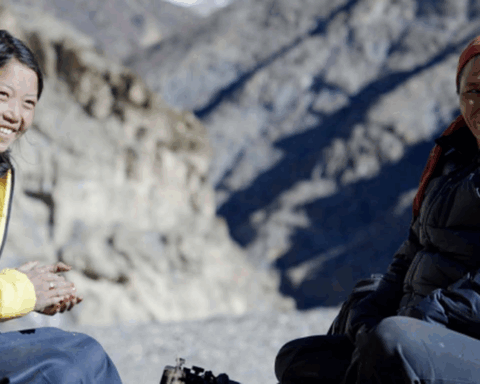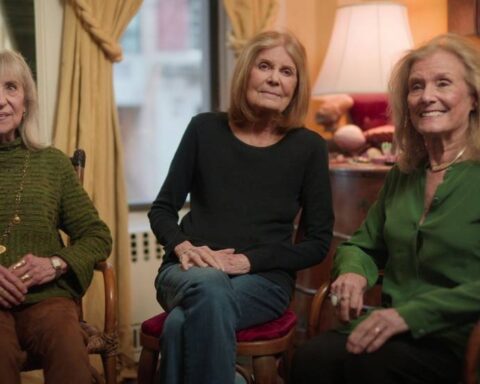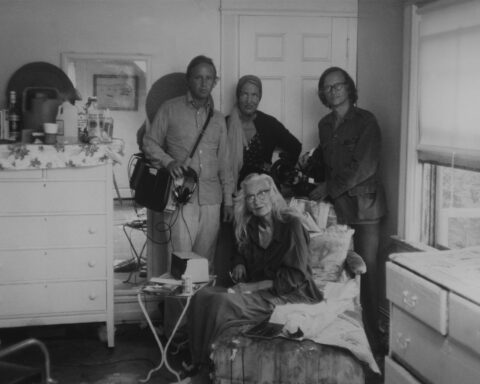The Spanish Poet Antonio Machado’s famous lines, “Traveller, there is no road, it is through the journey that you will find your way,” have a particular resonance with the life’s work of Canadian photographer Elaine Ling. Based in Toronto, where she recently passed away, Ling travelled the world far and wide in search of subjects for her photography, and in turn connected with communities and individuals around the globe.
Everyone who knew Ling personally speaks of her exuberance, her tireless curiosity for other cultures and her many talents outside of photography. She was a physician who maintained a medical practice until near the end of her life, a recognised musician who was a cellist in Orchestra Toronto (and also played other classical instruments), a canoeist, a passionate outdoors person and a world traveller par excellence. Ling visited at least 49 countries in five continents with her camera, returning to some countries multiple times—never on commissions or assignments, but always as part of a personal quest to create bodies of documentary work through which she could interpret ancient cultures and understand vanishing ways of life. She travelled with a seemingly childlike—though strategically placed—sense of wonder and curiosity that continually opened doors for her. She went to remote parts of the world like the Gobi Desert (Mongolia), anthropological sites like Cappadocia (Turkey), Petra (Jordan), and Angkor (Cambodia) and hard-to-reach corners in countries like Mali and Madagascar. She travelled by jeep, on horseback, or trekked on foot through rough terrain, sleeping in tents, and even under the stars. But her last trip was a train ride from Toronto to Vancouver, two months before she died, which she undertook as a form of ritual, saying goodbye to her adopted country through a train window. She had been diagnosed with stage-four lung cancer two years earlier, and by the spring of 2016 she was growing anxious about not being able to “finish” her work.
According to Laura Ramsey, head archivist of her photographic estate, Ling’s biggest concern in the months before she died was that she would not find the “right” institution to preserve her archives. Elaine and I had been discussing her archives for some time in the spring, and we considered many venues in Canada and the United States. Over dinner at the House of Chan, one of her favourite restaurants in Toronto, she said with a wry smile, “Time is running out for me. This will be my last year.” Finally, in May I was able to arrange a meeting with Brock Silversides, director of the Media Commons at the University of Toronto, who quickly rushed to see her work at home. Although I wasn’t able to attend the meeting and witness Silversides’ reaction to her work, Elaine later told me how moved he was by the beauty of the prints, her craftsmanship and the completeness of her records. He understood the importance of the collection, and agreed to accept her archives.
It was May 4, 2016 when Elaine conveyed this information to me in an emotional phone call, saying how proper it was for her archives to remain here because Toronto was her home and U of T her alma mater, having graduated from its medical school. Ramsey, who by then was spending four days a week in her home studio, said that a “huge, huge weight” had been lifted from Elaine, and she was ready to go on her farewell journey across Canada, accompanied by her niece, Jessica Pong. When she returned she was immediately hospitalised, but continued to work frantically from her hospital bed until one week before her death.
Incredibly, with a computer on her lap, notebooks and even a scanner strewn across the bed, she organised her archive, selecting negatives, making notes and planning a retrospective book that she would call Fascinations. Ramsey recalls, “I would come to her house [ in downtown Toronto ], pick up binders of negatives, walk over to the hospital, and Elaine would sit there. We brought a light table to the hospital and she was looking at negatives, putting sticky notes on everything that she liked. We would bring them back and scan them, then she would look at them again.” She selected 400 images from which a final edit will be made collaboratively for the new book.
In a career that spanned 30 years, Ling produced 11 portfolios, published four books—most notably Mongolia: Land of the Deer Stone (Lodima Press, 2009) and Talking Stones (Kehrer, 2016)—and held dozens of exhibitions around the world. Her work has been collected by some of the most prestigious institutions of photography in the world, including the Ryerson Image Centre, the National Gallery of Canada, the Smithsonian Museum, the Houston Center of Photography, the Bibliothèque Nationale de France and the Musée de la Photographie à Charleroi, among many others.
What is it about her work that has attracted the attention of so many curators and institutions? According to Paul Roth, director of the Ryerson Image Centre (RIC), Ling is “one of the most important photographers to emerge from Toronto’s collaborative photography scene of the 1990s and early 2000s.” In 2016, the RIC acquired an extensive series of 84 prints tracing her entire career, supplementing the university’s initial acquisition of a set of her photographs in 2002. Thanks to an endowment by the artist, the Ryerson Image Centre also annually awards the Elaine Ling Research Fellowship to a student of photography.
Ling was born in Hong Kong in 1946, immigrated to Canada with her family at the age of nine and grew up in the eastern edge of Scarborough, Ontario in the 1960s, where for many years they were the only Chinese family in the neighbourhood. Her father gave her a used Exacta 35mm camera when she was 13, which became her constant companion whenever she travelled, and helped her understand that the camera could bridge the chasms between her way of life in Canada and those of far-away cultures. Early in her medical career she worked in a hospital in Kathmandu, Nepal, where she documented women leprosy patients, and was deeply moved by the experience of photographing the contrast between “their deformed hands and their wrists, femininely adorned with multiple musical glass bangles.” After establishing a medical practice in Toronto, Ling spent several summers working with Ojibwa and Cree First Nations communities in the early 1980s. Assigned to Pikangikum, a small village of 600 people, she provided medical care as a fly-in doctor arriving regularly in a single or two-engine aircraft. Her brief sojourns with First Nations people—gaining their trust, sharing daily life, learning about respect for other cultures—were a transformative experience for the young Chinese-Canadian doctor, and propelled her to seek a parallel career as documentary photo artist. She purchased her first professional camera in 1974, at age 28, but was adamant about maintaining a medical practice while pursuing a stellar international career as a photographer.
As a newly minted, self-taught photographer, she made an astute and strategic decision to attend workshops, especially the Ansel Adams Advanced Black and White Workshop in Carmel, California, where she returned for eight summers and was able to photograph rocks and marine landscapes while learning both the craft and art of photography from such excellent practitioners as Michael Kenna and Joel Meyerowitz. What better place than Carmel and the surrounding area to learn about photography? The beauty of its natural rock formations has an almost mythical resonance as a locus of the medium, having been immortalised by one of the greatest photographers of all time, Edward Weston, in the 1930s. With amazing prescience, it was into this comfort zone that she chose to set her roots as she entered the new world of “art” photography.
In the welcoming ambience of the high-intensity workshop Ling found her perfect element. It was a place that offered one-on-one teaching, mentoring, expertise and practical help. Just as important for her were the sharing of ideas, opportunities for creating new work and, most of all, connectivity to an international community of photography that included practitioners, theorists, academics, private collectors and curators. By the 1980s, an international circuit of workshops had developed in conjunction with festivals of photography and other events where photographers were encouraged to exhibit their works and explore the medium as an art form. It was in this festival circuit that she found—or made—her metaphorical home, and which she used as a base for organising work trips to disparate parts of the world.
Ling once remarked that, as a musician, she had particularly fond memories of the Ansel Adams Workshop, where she got to play Ansel Adams’ famous piano. Adams, who had switched careers from concert pianist to photographer, approached the new medium with the precision of a pianist. Like him, Ling approached her new medium not only with the discipline of a classical musician, but with the precision of a medical doctor. Her brother, Edward Pong, said, “her photography was everything. She used her doctor’s income to fund everything.”
Ling kept absolutely meticulous notes and journals. According to Ramsey, she “would write the date, to the day, and sometimes even the time that she took the photograph, and the location. And then when she would make the print in the darkroom…she would take the original Polaroid positive, or she would take a photo copy of it, and she would make markings… dodging and burning notes…on the photo copy or the actual Polaroid. On the other side of the sheet she would have a grid. ‘Print No. 1’—and she would have the exposure time in the darkroom, the aperture, the enlarger, the day that she made the print, how many prints she made, and so forth. The chemistry, the developer that she was using, the height of the enlarger—and it changed for every print.”
Ling’s work is distinguished for its clean, un-manipulated, black-and-white images, in a style known as “straight photography” that dates back to a movement founded in the 1930s by a collective of photographers who called themselves Group f/64. It’s a genre which they defined as “possessing no qualities of technique, composition, or idea derivative of any other form.” She experimented with medium-format, 35mm and large-format cameras, but it was the 4×5in large format that became her signature trademark and she was an absolute master of it. Working with a large-format camera is a slow, methodical operation, for the apparatus is heavy and unwieldy and must be supported on a tripod. The photographer must cover her head under a dark cloth in order to focus and compose the picture on the ground glass, then insert a plate or sheet of film and wait for the right moment to make the exposure. As a result, people respond to it differently than small, hand-held cameras, which can be used surreptitiously to capture “fleeting” moments. With a view camera, one must deliberately engage the subject and work collaboratively with them.
In Mongolia, during five trips between 2002 and 2007, she had ample opportunity to work collaboratively. Ling had gone to photograph the desert landscape as well as the deer stones and Turkic stones, man-made sacred stones that have succumbed to the ravages of time for 3,000 years. But in the process she also photographed and wrote about the nomadic people of the Mongolian–Manchurian Steppe, a vast grassland “where nomads herd their sheep, goats, horses and cows through summer pasture.” It was there that she “met Mongolian nomadic families whom I would come to know and deeply respect…I found myself deeply engaged with a persevering and wonderful people.” Working with Dr. Nyamkhuu, the renowned surgeon and director of the country’s National Center for Infectious Diseases Studies, Ling was able to gain unfettered access to some of the most remote communities in the country. Few North American photographers have been able to enter into the lives of the nomads as intimately. For one diptych she had all the members of the family move first to one side of their ger (yurt)—a home built in the form of a round wooden-framed tent covered in white felt containing a single, large room—while she photographed the first half of the interior, then had them move over to the other side while she photographed the second half.
The horse is the mainstay of Mongolian nomadic culture. It’s used for travel and herding, as a beast of burden and for fermented mare’s milk, which is prized by Mongolians. It is also a status symbol, and one of Ling’s most famous photographs, “Young Mother Horseman,” depicts the pride of a young woman on her horse in front of her home. Ling recalled how the woman had just “galloped up to her ger, took her baby from her mother’s arms, breastfed it while standing, and then returned the baby and leapt back on the horse.” But Ling was ready with her bulky camera and held back the woman long enough to capture the heroic stance. The image unequivocally sums up the pride and confidence of youth and women, a symbol of the independent spirit of her people. The woman is a willing collaborator in the brief documentary photo session, and with her black horse in front of the white ger, Ling achieved a graphic and iconic composition.
Starting in 1995, Ling used Polaroid 55, a black-and-white instant sheet film as her primary material, which consisted of a negative and a corresponding positive (photograph), which could be developed on the spot. When she peeled the paper photograph away from the negative, she gave it to her subjects as a way of showing her appreciation. Ling wrote of one memorable incident that reflects the high level of bonding that she cultivated: “The evenings were filled with storytelling and singing…and much, much drinking accompanied the song. The custom is to pass around a common cup. I knew there was a high incidence of hepatitis in Mongolia, so I had brought my own ceremonial cup as a precaution. My reluctance to share their common vessel, usually a Chinese teacup, required a long explanation by my friend Nyamkhuu…the assembled nomads listened solemnly to his explanation of why I had brought my own cup. I was not being antisocial. When he finished, they nodded in agreement and then all proceeded to accommodate me by drinking from my cup!”
Composing her pictures in the camera, she enlarged the negatives to full frame, and included the rebate—the perforated edges and traces left by sticky tape that joined the cellulite negative and the paper positive together. The technique became her signature, proof that she was a “4×5 Polaroid girl,” as she was fond of saying. Ironically, it may not always have worked to the best advantage, sometimes resulting in a forced, aestheticized look. But her strength is to be found in the extremely high quality of her gelatin silver prints, which she always made herself, each one a performance of black, gray and silver tones on paper. The individual tones are delicate and subtle, yet the interplay between them is so intense that they deepen the sense of depth, almost engendering a momentary illusion of three-dimensionality.
In her picture of the ancient city of Petra, Jordan on the cover of Talking Stones, the weathered rock face, the smooth curves, the crevices and shallow caves resonate emotionally like music. Her representation of a site so steeped in time and history evokes a feeling of silence, a sacred silence which moves the viewer to imagine traces of a dead civilisation. Music and photography are both visceral experiences, and it should not come as a surprise that Ling—the musician-photographer—would innately approach her photographic subjects from a musical perspective. And therein lies the power of some of her best work, which effortlessly moves the emotions and leads the viewer to experience her elemental world of ancient stones. It is not so much about the stones that she documented, but about Ling’s emotional experience that is imparted to the viewer.
After Mongolia, she turned her attention to the Baobab trees of Madagascar, Mali, Ivory Coast and South Africa, producing a limited-edition portfolio of platinum prints, The Tree of Generations (2008-2010). Obsessed with desert landscapes, she was travelling to the Sahara Desert when she saw her first Baobab, an iconic and ancient tree that can easily live one or two thousand years. She had never photographed trees before, but fell in love with the idea of longevity, that this odd-looking tree could be as old as some of her ancient stone sites. She was totally captivated by its “enduring presence, perhaps even older than the legends that are passed down from generation to generation.” For her, “its roots are deeply intertwined with daily existence,” since the “tree of life” provides local communities with basic necessities like material for shelters, food and medicine. Some Baobabs have contorted shapes that are like parodies or caricatures of nature, at times resembling bloated tubular balloons or fantastical primeval beings. Ling approached them in the same way that she approached the ancient rocks: with a sense of reverence, in full sunlight, working with the shadows of the mid-day sun. She often posed a nearby villager to symbolize the unique relationship between the tree and the community, and to convey a sense of the scale of these giants. Looking at the largescale 30×40in prints—in this case digitally made from scans in a limited edition of platinum prints—one can almost feel the tension of the pre-historic giants that have survived the relentless heat of thousands of years.
Ling challenged herself constantly. Even with her classical work of the rock face of Petra she attempted to step beyond the “limits” of the straight image by digitally superimposing an image of a stone angel that she had made on the same site much earlier, in 1998. This was a significant departure from the purity of “straight” documentation, crossing an aesthetic line from documentary to conceptual interpretation. Technically, it was a simple montage of two analogue negatives, and while it may not necessarily have heightened the artistic achievement, it nonetheless revealed her determination to reinvent herself near the end of her life. Ling embarked on a new project called Shaman Gold, which sadly she wasn’t able to complete. Using a digital camera, she first photographed, in colour, miniature gold sculptures of mythical creatures at the Museo del Oro in Bogotà, Colombia. Ling wrote that “with the skin of gold ornaments a Shaman enters a different reality and can perceive the world through the eyes of a crocodile and a condor.” According to Ramsey, once in Toronto she then “hired dancers to come to the studio. She wanted them to be nude, she was very strict about that, wanting them to be raw. And she would show them the images of these gold pieces as inspiration for them to dance to—and jump and shape their bodies to imitate these objects,” as she photographed them against a dark seamless background. Assisted by Dan Ebert, she then blended them together as a digital montage, as if she were blending “time and space.” Though the reaction was mixed, Shaman Gold was a major conceptual experiment that most certainly would have led to a radical shift in her work.
Nevertheless, Ling left a rich legacy in the form of a passionate documentation of some of the most beloved sites of ancient civilisations. As Paul Roth eloquently stated, “she always made work from a place of passion and fascination. Whether they were portraits, landscapes or architectural views, her images all exemplify her conviction that there were places and people at the far end of every road, beyond every horizon and outside her knowledge, that could teach her something important and meaningful. This bedrock idea meant that all her photographs are suffused with her outsize energy, curiosity and sincerity, and with her fundamental humility in the face of remote cultures and places shaped over staggering periods of time.”











